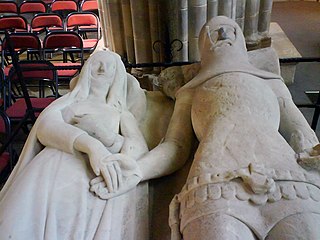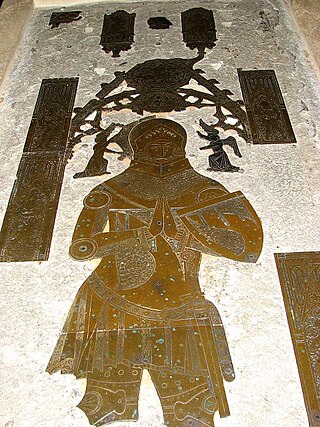See also
- Hugh Hastings Romilly (1856–1892), British explorer in the Pacific
Hugh Hastings may refer to:

The Battle of Hastings was fought on 14 October 1066 between the Norman-French army of William, the Duke of Normandy, and an English army under the Anglo-Saxon King Harold Godwinson, beginning the Norman Conquest of England. It took place approximately 7 mi (11 km) northwest of Hastings, close to the present-day town of Battle, East Sussex, and was a decisive Norman victory.

Richard Fitzalan, 3rd Earl of Arundel, 8th Earl of Surrey was an English nobleman and medieval military leader and distinguished admiral. Arundel was one of the wealthiest nobles, and most loyal noble retainer of the chivalric code that governed the reign of Edward III of England.

William de Valence, born Guillaume de Lusignan, was a French nobleman and knight who became important in English politics due to his relationship to King Henry III of England. He was heavily involved in the Second Barons' War, supporting the king and Prince Edward against the rebels led by Simon de Montfort. He took the name de Valence after his birthplace, the Cistercian abbey of Valence, near Lusignan in Poitou.

Odo IV or Eudes IV was Duke of Burgundy from 1315 until his death and Count of Burgundy and Artois between 1330 and 1347, as well as titular King of Thessalonica from 1316 to 1320. He was the second son of Duke Robert II and Agnes of France.

Eustace, also rendered Eustis, is the rendition in English of two phonetically similar Greek given names:

The first phase of the Hundred Years' War between England and France lasted from 1337 to 1360. It is sometimes referred to as the Edwardian War because it was initiated by King Edward III of England, who claimed the French throne in defiance of King Philip VI of France. The dynastic conflict was caused by disputes over the French feudal sovereignty over Aquitaine and the English claims over the French royal title. The Kingdom of England and its allies dominated this phase of the war, and Edward's sovereignty over Aquitaine was confirmed in the Treaty of Brétigny (1360), although he renounced his claim to the French throne.

John Hastings, 2nd Earl of Pembroke, was a fourteenth-century English nobleman and soldier. He also held the titles of Baron Abergavenny and Lord of Wexford. He was born in Sutton Valence, the son of Lord Hastings, and Agnes Mortimer. His father died when John Hastings was around one year old, and he became a ward of King Edward III while remaining in his mother's care. The King arranged for John to marry Edward's daughter Margaret in 1359, which drew John into the royal family. However, Margaret died two years later. John Hastings inherited his father's earldom, subsidiary titles and estates in 1368. The same year, he made a second marriage, to Anne, daughter of Walter, Lord Mauny. The following year, Pembroke began the career in royal service that continued for the rest of his life.

Sir Hugh de Courtenay, 2nd/10th Earl of Devon, 2nd Baron Courtenay, feudal baron of Okehampton and feudal baron of Plympton, played an important role in the Hundred Years War in the service of King Edward III. His chief seats were Tiverton Castle and Okehampton Castle in Devon. The ordinal number given to the early Courtenay Earls of Devon depends on whether the earldom is deemed a new creation by the letters patent granted 22 February 1334/5 or whether it is deemed a restitution of the old dignity of the de Redvers family. Authorities differ in their opinions, and thus alternative ordinal numbers exist, given here.

William the Conqueror had men of diverse standing and origins under his command at the Battle of Hastings in 1066. With these and other men he went on in the five succeeding years to conduct the Harrying of the North and complete the Norman conquest of England.
John Hastings, 1st Baron Hastings, was an English landowner, soldier and administrator who was one of the Competitors for the Crown of Scotland in 1290 and signed and sealed the Barons' Letter of 1301. He was Lord of the Manor of Hunningham.
John Hastings may refer to:

The Hundred Years' War was a series of armed conflicts fought between the kingdoms of England and France during the Late Middle Ages. It emerged from feudal disputes over the Duchy of Aquitaine and was triggered by a claim to the French throne made by Edward III of England. The war grew into a broader military, economic, and political struggle involving factions from across Western Europe, fueled by emerging nationalism on both sides. The periodisation of the war typically charts it as taking place over 116 years. However, it was an intermittent conflict which was frequently interrupted by external factors, such as the Black Death, and several years of truces.
Henry le Scrope, 1st Baron Scrope of Masham was an English soldier and administrator.
John de Cheverston, Captain of Calais, Seneschal of Gascony was a 14th-century English noble.

Sir Hugh Hastings I (c.1310–1347) was an English administrator and soldier. He fought for Edward III in the first phases of the Second War of Scottish Independence and the Hundred Years' War. His largely surviving monumental brass in Elsing Church in Norfolk is "one of the most celebrated of all English brasses".
Hugh Hastings II, Lord of Elsing, Brisley and Grimston, was an English soldier and noble. He fought in the Hundred Years' War.

Sir Adam de Everingham, 2nd Baron Everingham, Lord of Laxton, was an English noble who fought during the Second War of Scottish Independence and the Hundred Years' War.

Hugh Hastings III, Lord of Elsing, Brisley and Grimston, was an English soldier and noble who fought in the Hundred Years' War.

Sir Ralph Hastings, Lord of Allerston, was an English soldier and noble who fought in the Hundred Years' War.
Sir Edward Hastings was an English landowner and soldier who fought in the Hundred Years' War but spent much of his life and fortune on unsuccessful claims to hereditary honours.